Market Analysis
In-depth Analysis of Photonic Crystals Market Industry Landscape
The Photonic Crystals market is characterized by dynamic and multifaceted market dynamics that significantly influence its growth and evolution. Technological advancements form a pivotal aspect of these dynamics, with continuous research and development driving innovation in the field. As scientists and engineers discover new applications and optimize the properties of photonic crystals, the market experiences shifts in demand and product offerings. The ever-evolving nature of technology ensures that the Photonic Crystals market remains at the forefront of progress, with emerging applications in telecommunications, healthcare, and renewable energy contributing to its dynamic landscape.
Market demand is intricately tied to global economic conditions. Economic fluctuations can impact investments in research and development, influencing the pace of innovation and market growth. During periods of economic prosperity, businesses are more inclined to invest in advanced technologies, spurring demand for photonic crystals. Conversely, economic downturns may result in reduced R&D budgets and slower adoption of new technologies, affecting the overall market dynamics.
Regulatory factors play a crucial role in shaping the Photonic Crystals market. Stringent regulations related to environmental standards, safety, and product certifications can influence manufacturing processes and market entry barriers. Compliance with these regulations becomes a key consideration for companies operating in the market, as failure to meet regulatory requirements can hinder product development and market access.
The global nature of the Photonic Crystals market introduces geopolitical factors that impact its dynamics. Trade policies, international collaborations, and geopolitical tensions can influence the supply chain, market access, and overall competitiveness of companies in this space. Adapting to geopolitical shifts and fostering international partnerships are essential strategies for navigating the complexities introduced by global dynamics.
Market competition is intense, with companies vying for market share through various strategies. Product differentiation, pricing strategies, and technological innovations are common tactics employed by market players to gain a competitive edge. The dynamic nature of technological advancements requires companies to stay agile and responsive to changing customer needs and preferences, ensuring they remain at the forefront of market competition.
Consumer awareness and preferences contribute significantly to market dynamics. As awareness of the benefits of photonic crystals grows, driven by factors such as increased emphasis on sustainable technologies and energy-efficient solutions, consumer demand for products incorporating these crystals is likely to rise. Companies that align their offerings with evolving consumer preferences are better positioned to capitalize on emerging market trends.
Supply chain dynamics also play a vital role in the Photonic Crystals market. The availability of raw materials, efficient manufacturing processes, and streamlined distribution channels impact the overall cost structure and competitiveness of products. Disruptions in the supply chain, whether due to geopolitical events, natural disasters, or other unforeseen circumstances, can have cascading effects on market dynamics.
Market dynamics are further influenced by the integration of photonic crystals in various industries. The adoption of these crystals in telecommunications, healthcare devices, and renewable energy applications directly impacts market growth. Companies that successfully identify and capitalize on emerging application areas contribute to the overall expansion and evolution of the Photonic Crystals market.





Leave a Comment